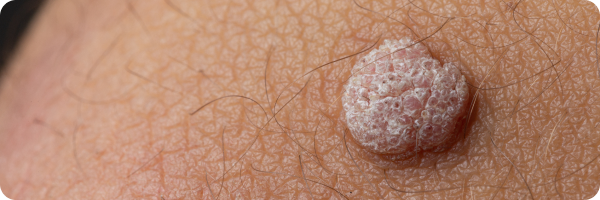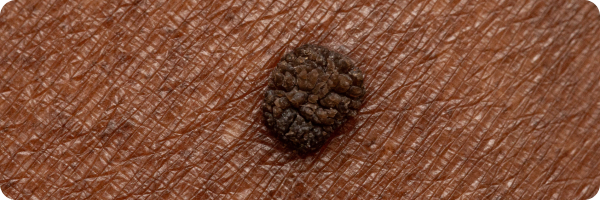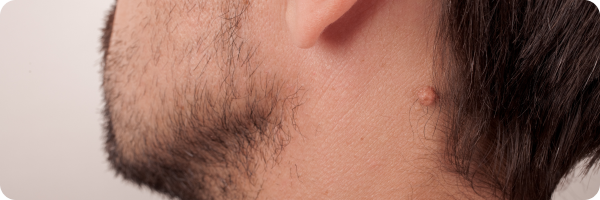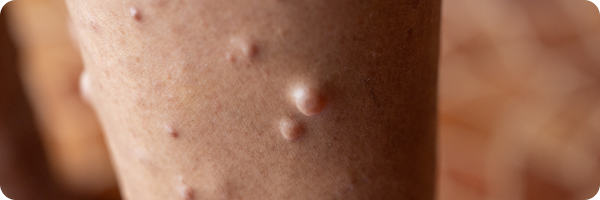Navigating how to get rid of skin tags
Skin tags, those benign growths that often linger on the skin, can be a nuisance for many. Though generally harmless, they may cause discomfort or aesthetic concerns, prompting individuals to seek safe removal options. In this guide, we’ll explore effective methods on how to remove skin tags, what causes skin tags and whether it is possible to remove skin tags overnight, while emphasising safety and efficacy.
What causes skin tags?
Skin tags, medically termed acrochordons, are soft, flesh-coloured growths typically found dangling from the skin. It is thought that as many as 60% of adults will develop skin tags at some stage of their life.
Key points to note:
- Appearance: Skin tags often resemble tiny flaps of skin, matching the skin’s tone or slightly darker.
- Common Locations: They tend to develop in areas where skin creases, such as the neck, underarms, eyelids, breasts, and bottom.
- Size Variation: Skin tags can range from minuscule to larger protrusions, with sizes typically spanning from 1mm to 2cm.
There are several factors that may contribute to skin tags developing, although the precise cause of skin tags remains uncertain.
- Friction: Skin-to-skin and skin-to-clothes contact is thought to pay a role in skin tag formation as they typically occur in skin folds.
- Hormonal Changes: Pregnancy and hormonal fluctuations throughout gestation can trigger the growth of skin tags. These typically disappear during the postnatal period.
- Age: The likelihood of having skin tags increases with age.
Skin tags are generally more of a cosmetic annoyance than a serious health problem. They can sometimes, however, cause discomfort and/or itching. If this is the case, and skin tags are impacting your quality of life or if you have a skin tag that bleeds or that develops into lots of skin tags, seek advice from your GP.
What can skin tags tell us about our health?
While skin tags themselves are typically not dangerous, they can give great insight to different processes in the body. Skin tags have been associated with conditions like obesity, type 2 diabetes, and dyslipidaemia.
Studies have found connections between skin tags and an increased risk of heart disease, metabolic syndrome and insulin resistance. Higher blood pressure and a higher levels of C-reactive protein (an inflammatory marker in the blood) were found in people with skin tags compared to those without skin tags.
There is a strong association between skin tags and polycystic ovarian syndrome (PCOS). Although the specific underlying mechanisms are not yet known, both skin tags and PCOS are linked with hormonal imbalances, obesity and metabolic dysfunction.
Metabolic dysfunction refers to abnormalities or problems in the body’s metabolic processes. These include how your body breaks down food for energy, manages nutrients like carbohydrates, fats, and proteins, and regulates hormones such as insulin.
If you would like to learn more, check out our guide on how to support your metabolic heath
Emerging research suggests there may be a possible trend between thyroid disease and skin tags, but more evidence is needed.

Skin tags may also coincide with acanthosis nigricans, which is a skin presentation characterised by dark, thickened patches of skin, often with a velvety texture. These patches also usually appear in skin folds and creases, such as the neck, armpits, groin, and back of the neck. Acanthosis nigricans are also often associated with insulin resistance, obesity, hormonal disorders, and certain medications.
Effective Treatment Options
Although skin tags are generally benign and may not need removal, individuals may opt for removal for cosmetic reasons or if they cause irritation. If you are considering having skin tags removed, there are a few things to consider when choosing effective treatment options.
Consult a medical professional:
Seeking professional guidance ensures safe and effective removal. If you are concerned about a suspected skin tag your GP should be able to evaluate your skin to determine if there are any worrying features that might warrant removal for clinical reasons. Removal of lesions for cosmetic reasons is usually not covered by the NHS. If NHS coverage isn’t available but you want to get rid of your skin tags for cosmetic reasons, you might wish to consider consulting with a private medical provider.
Skin tags may be removed by:
- Surgical Excision: Skin tags can be surgically removed using scissors or a scalpel.
- Cauterisation: This procedure involves burning or freezing the skin tag for removal.
- Cryosurgery: Liquid nitrogen is applied to freeze off the skin tag.
Post-Removal Considerations:
After removal, it’s important for individuals to be aware of possible side effects such as scarring or darkening of the skin (hyperpigmentation) at the site where the skin tag was, especially for those with darker skin tones.
Home Remedies:
The NHS advises against home skin tag removal unless advised by your GP. The internet offers numerous home remedies for skin tags, like using duct tape, tying with dental floss or applying various substances like oregano oil, tea tree oil, and others to dry out or irritate the skin. Sites may also share various techniques on “how to get rid of skin tags overnight”. However, it’s important to note that these remedies are not recommended, as they can lead to an increased risk of scarring, bleeding and infection.
Our clinical lead and GP, Dr. Claire Thomas, has seen several unfortunate incidents where people have tried to remove skin tags at home. In some cases this has led to unpleasant infections, which can be especially nasty when a mole has been misidentified as skin tag.
There are also differential diagnoses for skin tags (possible alternative conditions that can present similarly).
Differential diagnoses may include:
- Warts (verrucae): These are caused by human papillomavirus (HPV) and can sometimes resemble skin tags, but they usually have a rougher texture.

- Seborrheic keratosis: These are noncancerous growths that can vary in colour and may (rarely) be mistaken for skin tags, but they often have a more waxy or stuck-on appearance.

- Moles (naevi): While moles can differ in appearance, some smaller or flat moles may resemble skin tags.

- Neurofibromas: These are benign tumors of nerve tissue and can, in some instances, resemble skin tags, particularly if they occur in clusters.

Can skin tags be prevented?
It’s complicated…while there is nothing that will 100% safeguard against getting skin tags, there are steps that may reduce their likelihood of occurring:
- Maintaining a healthy weight: Skin tags often form in skin folds. They’re often found more commonly in people who are overweight or have diabetes because of increased repetitive friction between skin folds. If you are looking for weight loss tips, you may like our article on how to reduce BMI.
- Managing blood insulin levels: Research suggests that insulin may act as a driver of skin proliferation, causing more skin tags to grow. To learn more about insulin and insulin resistance, check out our article: What is insulin resistance and how to reduce it
- Wearing looser clothing can prevent existing skin tags from getting bigger and reduce irritation by decreasing constant friction.
It’s always recommended to have any new or changing skin growths evaluated by a healthcare professional to ensure an accurate diagnosis and appropriate treatment, as some skin conditions may require medical attention or monitoring.
For more health and wellbeing tips to support you on your wellness journey, download the free Evergreen Life app today.
Reviewed by:
Anna Keeble MA BA Head of Content and Wellbeing Expert
Dr Claire Marie Thomas MRCGP DFSRH DTMH DipNLP MBChB BMedSci Medical Expert
- Artar, G., Tas, B., Turan, G. and Uckan, H.H. (2022). Evaluation of androgen-dependent skin findings of polycystic ovary syndrome (PCOS). Gynecological Endocrinology, 38(12), pp.1–5. Available here.
- Brady, M.F. and Rawla, P. (2019). Acanthosis nigricans. [online] nih.gov. Available here.
- Chiriac, A.E., Chiriac, A., Naznean, A., Podoleanu, C. and Stolnicu, S. (2018). Home remedies for skin tags: Not recommended! International Journal of Clinical Practice, 72(7), p.e13209. Available here.
- Farag, A.G., Maree, A.H., Zytoon, A.A., Labeeb, A.Z., El-Rahman, R.A.I.A. and Elshaib, M.E. (2021). Carotid Intima-Media Thickness; Could Be an Early Predictor of Atherosclerosis in Skin Tags Patients. Annals of the Romanian Society for Cell Biology, [online] 25(4), pp.2369–2377. [Accessed 9 Apr. 2024]. Available here.
- Higgins, J.C., Maher, M.H. and Douglas, M.S. (2015). Diagnosing Common Benign Skin Tumors. American Family Physician, [online] 92(7), pp.601–607. Available here.
- NHS (2017a). Acanthosis Nigricans. [online] http://nhs.uk . Available here.
- NHS (2017b). Skin tags. [online] http://nhs.uk . Available here.
- Pandey, A. and Sonthalia, S. (2023). Skin Tags. [online] http://europepmc.org. [Accessed 8 Apr. 2024]. Available here.
- Platsidaki, E., Vasalou, V., Gerodimou, M., Markantoni, V., Kouris, A., Vryzaki, E., Gregoriou, S., Rigopoulos, D. and Kontochristopoulos, G. (2018). The Association of Various Metabolic Parameters with Multiple Skin Tags. The Journal of Clinical and Aesthetic Dermatology, [online] 11(10), pp.40–43. Available here.
- Putra, I.B., Jusuf, N.K. and Kartayana, J. (2017). Qualtiy of Life Assessment in Skin Tag Patients. Sumatera Medical Journal, 1(01), pp.31–36. Available here.
- Sanchez-Garrido, M.A. and Tena-Sempere, M. (2020). Metabolic dysfunction in polycystic ovary syndrome: Pathogenic role of androgen excess and potential therapeutic strategies. Molecular Metabolism, 35, p.100937. Available here.
- Sari, R., Akman, A., Alpsoy, E. and Balci, M.K. (2009). The metabolic profile in patients with skin tags. Clinical and Experimental Medicine, 10(3), pp.193–197. Available here.
- Singh, BhabaniS.T.P., Tripathy, T. and Kar, B. (2019). Association of skin tag with metabolic syndrome and its components: A case–control study from Eastern India. Indian Dermatology Online Journal, 10(3), p.284. Available here.
- Vora, R., Gupta, R., Mehta, M., Chaudhari, A., Pilani, A. and Patel, N. (2014). Pregnancy and skin. Journal of Family Medicine and Primary Care, 3(4), p.318. Available here.







